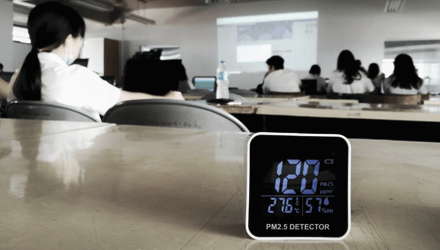By Sophie Neaves on Mon 03 April 2023 in Blog
UK Air Quality Analysis: The Pollution & Schools Report

This research was conducted by air quality and ventilation solutions experts Airflow Developments. Material is available to re-publish, with credit (including link) to Airflow. Please get in touch for additional information.
Air quality is the term used to describe the level of pollution in the air we breathe.
A 2019 review by Public Health England published named poor air quality as “the biggest environmental threat to health in the UK”. It also revealed that, whilst air quality has shown signs of improvement in the last decade, the UK’s annual mortality rate from human-made air pollution is between 28,000 and 36,000 deaths.
Children are among those affected most by air pollution. They breathe more rapidly than adults and so absorb more pollutants, plus they have smaller airways. Additionally, they suffer from more respiratory infections than adults, making them more susceptible to the effects of air pollution.
Providing adequate ventilation in classrooms is vital, but air quality outside schools is just as important. However, more than a million UK children are being educated in areas with high levels of harmful air pollution, spending at least 32.5 hours there every week. A previous study has highlighted the effects poor classroom air quality can have on schoolchildren, including impacting behaviour, concentration and health.
The government is committed to the Clean Air Strategy 2019, which aims to cut air pollution, making our air better for us and the environment. Individual local authorities and councils also have a responsibility to improve the situation for their residents, by setting and working towards their own objectives. At the same time, however, councils are constrained by poor levels of funding and expertise gaps.
Charting the scale of the problem
At Airflow, we analysed the latest available air quality data from Defra, to discover which areas of the UK had the poorest air quality over the last year. We then calculated how many schools are in the worst-affected areas and examined what councils/local authorities are doing to help these vulnerable schoolchildren.
We compared the amounts of five key pollutants against the government’s national air quality objectives (NAQOs) for maximum levels, as an indicator of the air quality in each area:
- Nitrogen dioxide (from fossil fuel combustion, vehicles and power plants)
- Sulphur dioxide (largely from electric utilities, especially those that burn coal)
- Ozone (from industrial sources, vehicles, fossil fuels, consumer products and the evaporation of paints)
- Particulate matter (PM2.5 & PM10) (predominantly from combustion sources like vehicles, diesel engines and industrial facilities)
Key findings
- London is home to 7 out of the 10 worst-affected areas
- Kensington and Chelsea had the worst overall air quality
- Leicester is 5th on the worst-affected areas list, with the poorest air quality outside London
- 315,045 children (at 686 schools) are at school in the worst five areas
- Cardiff has higher particulate matter (PM2.5) levels than London
- 1.4 million schoolchildren are exposed to unsafe levels of nitrogen dioxide
- Manchester’s nitrogen dioxide levels are 17 times higher than those in the Isles of Scilly
Are councils doing enough to support schools in improving air quality?
Under new plans announced by Defra in August 2022, local councils will have a strengthened framework for improving air quality. But it doesn’t explicitly require them to focus on helping the most vulnerable, including schoolchildren.
Plus, only local authorities declared Air Quality Management Areas are required to have an Air Quality Action Plan.
According to a survey we conducted in 2022, over a quarter of teachers (27%) said they knew of efforts to improve air quality that were abandoned due to a lack of funding or government support.
Where in the UK are children exposed to poor air quality?
We analysed the levels of pollutants, against government targets for maximum levels, across the UK. The chart below shows the 10 worst-performing areas, as well as how many children there are being exposed to poor air quality during school hours.
1. Kensington and Chelsea
This London borough has unsafe levels of nitrogen dioxide (NO2): 6% higher than the London average and 59% higher than the national average.
After being designated an Air Quality Management Area (AQMA) due to exceeding maximum levels for NO2 and particulate matter (PM10), the borough published its Air Quality Action Plan for 2022-2027.
Part of the plan involves reducing emissions from existing buildings (including schools) and extending the School Streets programme, which restricts motorised traffic during school run times. The borough also intends to work with schools to undertake their own monitoring.
2. Redbridge
Redbridge borough became an AQMA in 2003 and their action plan runs from 2020 to 2025. However, during its first year (2020-21) the annual mean level of NO2 actually increased.
Exceeding national targets, Redbridge had the third-worst levels of PM10 in 2021 and higher levels of NO2 than Kensington and Chelsea.
Vehicles are the biggest cause of air pollution in Redbridge. To limit emissions’ impact on schoolchildren, however, Redbridge has clean air zones around schools, including anti-idling and road closure measures at the start and end of the school day.
3. Enfield
In terms of PM10, Enfield’s levels are 38% higher than the national average. Unsurprisingly, most of the air pollution in the Enfield AQMA comes from road traffic, a leading cause of PM10 particulate matter.
The council is helping schools to implement School Travel Plans, which promote active, more environmentally-friendly school runs. However, initiatives like these will take time to have an impact and rely upon people choosing alternative methods of travel.
4. Barnet
Some 169 schools are located in Barnet, teaching almost 70,000 students – more than any other location in the 10 poorest air quality areas. These children are being exposed to the 11th highest levels of NO2 in the UK and the 5th highest levels of PM10.
Barnet introduced an Air Quality Action Plan in 2017, to run till 2022. However, NO2 levels were higher in 2021 than in 2020, suggesting more needs to be done.
5. Leicester
Outside of London, Leicester suffers from the UK’s worst air quality, with PM2.5 levels 29% higher than the national average. It’s also home to 61,000 schoolchildren, who are more susceptible to the effects of poor air quality.
Despite Leicester’s 2015-2026 action plan, NO2 levels rose in 2021, although they still remain within legal limits. The plan focuses less on schools than some others, but there has been an increase in the uptake of more sustainable transport methods. School Streets have also been trialled, but only on a limited scale.
6. Haringey
Haringey’s first Air Quality Action Plan was published in 2003. However, two decades later, it is still one of the UK’s worst areas for air quality.
It comes 12th out of 374 local authorities for the highest levels of PM2.5 particulate matter, while NO2 levels also increased in 2021.
With 42,044 schoolchildren in Barnet, the borough’s latest action plan prioritises “reducing pollution in and around schools and extending school audits to other schools in polluted areas”.
7. Cardiff
Cardiff experiences some of the UK’s poorest air quality, and the worst in Wales, with PM2.5 levels higher than in London.
Parents with children at Cardiff’s 144 schools have even demanded air quality monitors. Responding to these calls, Cardiff Council said: “There is no safe level of air pollution when it comes to public health.” But, it said, installing every school with an air quality monitor “might not be the best use of available resources”.
8. Kingston upon Thames
NO2 levels are above the legal limit in Kingston, where there are 30,903 schoolchildren in 64 schools.
According to the borough’s Air Quality Annual Status Report for 2021, progress has been made on many of their air quality action points. However, planned air quality audits have not yet been carried out due to limited resources.
9. Walsall
One of the UK’s busiest roads, the M6, passes through Walsall, with many of the town’s 50,000 schoolchildren learning in close proximity to the road.
Whilst Walsall is deemed to have “safe” levels of NO2, this situation has worsened in the past year. Unsurprisingly, levels of the pollutant are particularly high near the M6.
10. Hillingdon
As well as being in the worst 10 performing places overall for air quality, Hillingdon is in the top 10% for PM2.5 levels. Yet, it’s also home to almost 60,000 schoolchildren.
To help those children, the borough’s action plan includes a ‘no idling at schools’ campaign, more School Streets, an air quality awareness package for schools, and green barriers between schools and roads.
Poorest overall air quality outside London
Large cities outside of London have some of the poorest air quality, but so do many more rural areas close to high-traffic motorways and A roads. Running through West Northamptonshire is the M1, one of the UK’s busiest motorways, with an estimated 300,000 cars per day. Some of the busiest sections of the M1 are around J7 and J6A near St Albans, where there are high levels of PM2.5 and PM10.
This all emphasises the profound effects of vehicle emissions on air quality.
How are schools affected by NO2 pollution?
Areas with the highest NO2 levels in the UK
- Manchester
- Tower Hamlets
- Birmingham
- Caerphilly
- Brent
Looking solely at nitrogen dioxide levels, Manchester, the London borough of Tower Hamlets and Birmingham stand out as the worst-affected areas. Manchester’s NO2 levels are double the national average.
These areas are also home to more than 350,000 schoolchildren. In total, almost 1.4 million students are attending schools in areas with unsafe levels of NO2.
The Isles of Scilly were the area least affected by NO2 pollutants, but only 263 pupils attend schools there. The islands’ NO2 levels were 17 times less than those of Manchester.
Methodology
- Nitrogen dioxide by local authority, 2021
- Sulphur dioxide by local authority, 2021*
- PM2.5 annual by local authority, 2021
- PM10 annual local authority, 2021
- Ozone max. daily 8hr running mean by local authority, 2021
We ranked each local authority/borough for each pollutant – the lower the concentrations of the pollutant, the higher the ranking – and created an average of these rankings to give an overall score. This told us the areas with the worst overall air quality.
The map represents these scores and gives a rank to each local authority based on the score.
Data on the number of open schools in the UK was collected from get-information-schools.service.gov.uk. Schools in Wales did not provide the number of pupils.
We then researched the existence of council-led measures or regulations in place to improve the quality of air.
*Where SO2 data was not available for the local authority, we took the annual mean for the zone agglomeration (region) the local authority falls within. London data has been split into individual boroughs.


